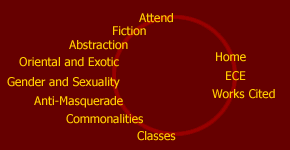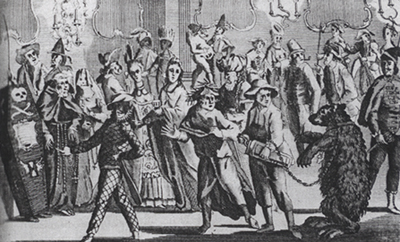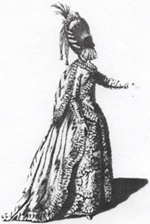



 Masquerades
flourished in eighteenth century England as one of the primary forms of entertainment
and social life [1]. Although these masquerades varied greatly
from one another, there were specific elements that tended to be common to all
of them. These commonalities ranged from specific costume types to the general
atmosphere and traditions.
Masquerades
flourished in eighteenth century England as one of the primary forms of entertainment
and social life [1]. Although these masquerades varied greatly
from one another, there were specific elements that tended to be common to all
of them. These commonalities ranged from specific costume types to the general
atmosphere and traditions.
All the participants at a masquerade had to be masked and in disguise [2].
Perhaps the most frequent sight at a masquerade was the "domino" costume [3].
Venetian in origin [4], this disguise was very simple; it was
comprised of a dark loose cloak that enveloped the body accompanied by a mask.
Sometimes the mask was accompanied by a hood called a "bahoo" [5].
These costumes were usually black, but occasionally varied to white and blue
[6]. The domino costume represented intrigue, adventure, conspiracy
and mystery, four elements that were a distinct part of the masquerade atmosphere.
The Domino costume was also often worn by both sexes [7].
 In
addition to the presence of the Domino costume, most masquerades were also similar
to each other in their enforcement of "strict rules of dress and etiquette"
[8]. Everyone had to be disguised. The Swiss Count, John James
Heidegger, was the leading impresario for masquerades in the beginning of the
century [9]. The sponsor of many public balls, Heidegger "refused
entry to anyone not attired in something clearly identifiable as costume" [10].
Furthermore, there was a specific code for verbal behavior at these balls. When
masked attendees addressed one another, they employed the use of set phrases
such as "I know you" or "Do you know me?" in order to begin a conversation [11].
These rules were important to the establishment of some sort of order amidst
an otherwise chaotic environment. Masks were usually removed after the supper
meal or after the midnight hour [12].
In
addition to the presence of the Domino costume, most masquerades were also similar
to each other in their enforcement of "strict rules of dress and etiquette"
[8]. Everyone had to be disguised. The Swiss Count, John James
Heidegger, was the leading impresario for masquerades in the beginning of the
century [9]. The sponsor of many public balls, Heidegger "refused
entry to anyone not attired in something clearly identifiable as costume" [10].
Furthermore, there was a specific code for verbal behavior at these balls. When
masked attendees addressed one another, they employed the use of set phrases
such as "I know you" or "Do you know me?" in order to begin a conversation [11].
These rules were important to the establishment of some sort of order amidst
an otherwise chaotic environment. Masks were usually removed after the supper
meal or after the midnight hour [12].
Finally, all masquerades, regardless of their location or attendance, carried with them a strong atmosphere of the "carnivalesque" [13]. Set in the late evening hours, the masquerade ball environment was festive, noisy and gay. Music and lavish food and drink played a crucial role in establishing this atmosphere. Eating, drinking and gambling was "unrestrained" [14]. The ballrooms were often decorated with lights [15], in order for participants to enjoy the festivities late through the night [16]. The impetus for masquerades varied; sometimes they were held in honor of royalty or to celebrate special occasions. Whatever their reason, masquerades were always festive and full of delight.
Endnotes
1. Ribiero, Aileen. The Dress Worn at Masquerades in England
1730 to 1790. New York, NY:
Garland Published, 1984, 3.
2. Ribiero, 3.
3. Castle, Terry. Masquerade and Civilization: the Carnivalesque
in Eighteenth-Century English
Culture and Fiction. Stanford, CA: Stanford
University Press, 1986, 59.
4. Ribiero, 29.
5. Castle, 59.
6. Castle, 59.
7. Ribiero, 29.
8. Ribiero, 22.
9. Ribiero, 3.
10. Castle, 75.
11. Castle, 35.
12. Ribiero, 28.
13. Castle, 24.
14. Castle, 26.
15. Castle, 25.
16. Castle, 26.